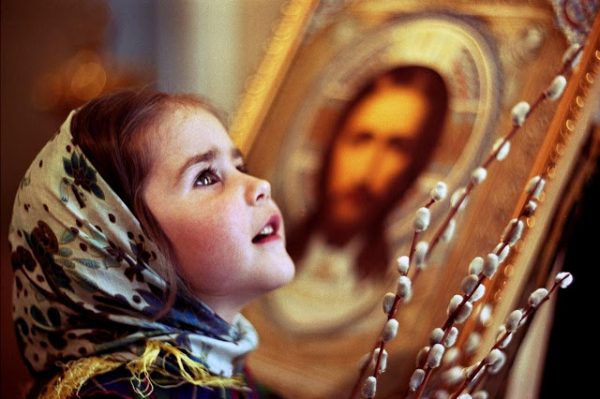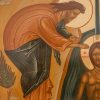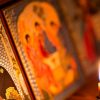Today is the first Sunday of Great Lent, on which we celebrate the Triumph of Orthodoxy.
In our parish and in parishes around the world, we will process with icons held high, celebrating together the rightful return of icons to the church so many years ago. As you know, icons were removed from our churches in the 8th century, and then fully restored in the 9th century. The Sunday of the Triumph of Orthodoxy celebrates the return of the icons to their rightful place in Orthodox worship.
Those of us who live in the West, are a minority in nations filled with people who do not revere and often, do not like, icons. This day offers us an excellent opportunity to discuss icons with our kids — both why and how we use them, why other people don’t like them, and what they’re missing out on. Most importantly, this is an opportunity to talk about how we Orthodox understand the materiality of this world and its potential for holiness.
We know that in the beginning, God was there, and He created everything — he created the planets and the stars, the land and the water and the air. He made plants and animals and human beings. And at the end of each day of this work, He saw that it was good.
All of the material of this world, the dirt and the rocks and the wood, the people and animals and the oceans, all of it is good.
In the Garden of Eden Adam knew that it was good. He received the gifts God gave them and held them up to the Lord, blessing them and thanking Him. There was a beautiful flowing energy of blessing and goodness of gratitude and gifts. God gave Adam received an offer to back gratitude and this gratitude allowed God to multiply his blessings even more!
One day, however, Adam and Eve broke the cycle of blessing and thanksgiving. A serpent told them that they could be like gods, so they ate fruit without God’s blessing and without gratitude for His generosity. They took what they wanted in the hopes of usurping God’s position, of ruling in His place.
They disrupted the cycle of blessing and thanksgiving, and Paradise was closed to them: they took all of creation with them into the fallen world, newly subject to corruption, decay and death.
In its original state, everything created was good. All of these material things were holy. The reason that the material world isn’t properly holy anymore is because Adam and Eve’s stewardship was lacking, because we led creation into that fallen state.
Now here we are, on the other side of things, coming into Great Lent.
We remember that Adam and Eve fell because they refused to fast, and now we enter our own fast.
St. Anthony the Great teaches us that ‘it is not a sin to eat: it is a sin to eat without gratitude’ so we eat gratefully, showing our love by eating according to God’s rules, according to the guidelines set out by our Holy Church.
We sanctify the human body by fasting, by doing prostrations and breathing in incense. We sanctify it by the sacraments – baptism and chrismation, holy unction and of course, holy communion, when we take Christ into ourselves, when we receive the divine at the chalice.
But it’s not just our bodies that we sanctify. We are sanctifying all of matter. When our priests and bishops perform services to bless holy water and holy oil, God is sanctifying matter. When we ask God to bless our food and our homes, we’re asking Him to sanctify matter. We can go into the wilderness and glorify God for the forests and the waterfalls, and we can ask Him to bless them and sanctify them. Part of our larger project as human beings is to restore the world to the Kingdom of Heaven, to that holy, sanctified state of Paradise.
Indeed, we know that the Holy Spirit itself is everywhere present and fills all things — it fills all things. The Holy Spirit is present in all of the things, all of the matter, all of the stuff. You and I, our bodies are temples of the Holy Spirit. This entire world can be a temple of the Holy Spirit, if human beings would just start worshipping God in everything they do.
It is with this worldview, this perspective on God’s creation, that the Orthodox embrace icons.
You see, the argument against icons is that while God is uncreated and infinite, icons are just lousy old matter; they’re wood and paint, or paper and glue. They’re not God, and we shouldn’t confuse them with God.
Now of course, we know that. We worship only the uncreated God; we do not worship icons.
But we do venerate them, we do love them. That’s because we don’t see the world as being split between the spiritual and the physical. We don’t agree that it’s body vs. soul and material vs. transcendent, stuff vs. God. God created the material stuff, and He saw that it was good. He also created Adam and Eve — human beings made up of both body and soul, both the material and the transcendent. And He saw that it was good. The Holy Spirit fills everything. We can love matter, because God has declared that it is good, and has filled it with His Holy Spirit.
It’s ok to venerate some matter – to show respect and love, to consider something holy and sacred. Matter can be sacred.
Children from the later preschool years and up can understand the story of the iconoclasts, who successfully removed icons from the churches. Throughout history, various heresies have risen up. A group of people has started to preach the faith differently, coming up with ideas that just aren’t true. Whenever this happened, our Holy Church would convene a Council of bishops and patriarchs to discuss this strange teaching and to clarify our common teaching. In that spirit, teaching about the iconoclasts is not just an interesting historic note, but it’s really a great introduction to how the Church works: the complaints and different teachings of the iconoclasts caused the Church to consider how it does things, and eventually a Council declared that icons were good, and they produced a sort of do’s and don’ts for the use of icons.
Back then, there were apparently those who would mix paint scrapings into Holy Communion, elevating the icon somehow to become Christ’s body and blood, and there were people who would take an icon as their godparent at baptism. The Church agreed that this was too much, it was excessive, and those concerns have helped us to develop the clarifications that we pass onto our children today: we venerate icons, but we do not worship them. When we look at an icon, as we commonly say, we are looking at a window to heaven! We are seeing through the paint and the wood, to the real person – whether Christ or one of His Saints – whom we know to be with our Father in heaven right now. When we look at an icon of our Lord and start praying, our prayers are directed to Christ, not to an icon. We do not ask the icon of the Theotokos to pray for us; we ask the Theotokos herself to pray for us, with the aid of her icon before us.
Icons are a visible confirmation of an invisible reality.
In church, as we celebrate the Divine Liturgy, we know that we’re joined by countless saints and angels, but we cannot see them. By covering the walls with iconography, make that invisible reality, visible.
No one will ever ask you if you have faith in the material, visible world — of course you do. We have knowledge of things that exist materially; we know what water is and what rocks are. It’s the invisible things, the immaterial things, like God and the saints who intercede for us, that require faith.
When one first comes to the basic question of whether we believe in God, we are asking ourselves if we can believe in the invisible.
The icon helps us to focus on the person with whom we are communicating, but it does more than that. It presents their material, historic reality to us, as we pray. These are real people, who lived in this real world, and had faces and personalities and experiences. The icon helps to keep us rooted in this truth, lest our fantastic, creative minds begin to reinvent those real people.
I grew up without icons, and without traditional prayers, and as I often tell my kids, I had this way of praying to Jesus where I would explain myself — why I was angry with someone or why I had decided to do the wrong thing — and because my way of praying was really talking to myself, I almost always decided that because Jesus loved me, He agreed with me.
Surely Jesus does not agree with us when we’re off to do the wrong thing, but I had a way of just declaring His agreement.
The problem is that I was treating Jesus like my imaginary friend — an invisible playmate who would do what I wanted when I wanted it. But Jesus is not imaginary; He’s very real.
The icon shows us Christ’s reality: He truly came down to the earth and took human form. He had a body and a face — He was a specific human like us, only unlike us, He was also fully God. He was material and visible, so when we depict Him in an icon, we are seeing Jesus Himself, not our imaginary friend. The icon helps remind us that Jesus is not who we make of Him; He is Himself, and we are not free to create a new Jesus to make ourselves feel better.
Our icons are windows to heaven, showing us those angels and Saints who are already there in the Kingdom, and they’re tools to help us focus when we pray. They can even be a call to prayer – how many of us will see an icon and cross ourselves, sanctifying our bodies and calling our hearts to prayer?
At the earliest ages, we should be teaching our children how to venerate icons. They should be crossing themselves and kissing the icons. I tell my kids that we kiss an icon when we walk into the room just as we’d go over and kiss our grandparents when entering a room. As we enter, we recognize the presence of our loved ones, we stop and we greet them with a kiss and a few words, to show our love and respect for them. It’s natural to treat the icons of our Lord, of his Mother and all of the Saints, our beloved intercessors, with the same love and respect.
This Sunday is the first Sunday of Great Lent. Here, as we begin to sanctify our bodies and our hearts by fasting and praying, we stop to celebrate the triumph of the Orthodox icon.
In our parish, all of the Sunday School will join the procession. Even our littlest kids will hold up their icons proudly and process with Father this Sunday. Parents will carry infants in their arms as the babies slobber over icons. Being a part of a procession teaches them something about being a member of this Holy Church, and about our joy at openly celebrating our beloved icons.
If you’d like to teach older children a clear history of icons, I do recommend Mary Paloumpis Hallick’s book, The Story of Icons, published by Holy Cross Orthodox Press, which is written for our older youth and covers the full history of icons.
We Orthodox talk about how every human being is an icon of Christ, for every one of us is made in His image. May we all begin to see the icon of Christ inside ourselves and inside every human being on this earth! Furthermore, may we pray that we become true icons, windows through which those around us might glimpse the Kingdom of God!
Good Strength for a Fruitful Lent! Kali Dynami!

















